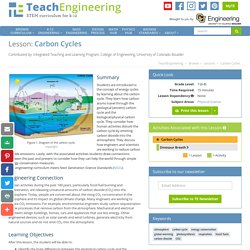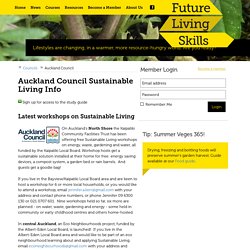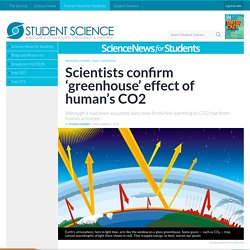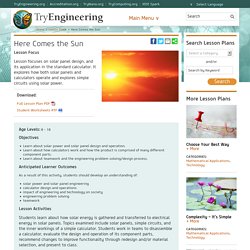

Carbon Cycles - Lesson. Summary Students are introduced to the concept of energy cycles by learning about the carbon cycle.

They learn how carbon atoms travel through the geological (ancient) carbon cycle and the biological/physical carbon cycle. They consider how human activities disturb the carbon cycle by emitting carbon dioxide into the atmosphere. Earth Day is here...Watch the Human Foot Print Pt. 1 (of 10) Carbon Cycle – Origami Organelles. Teach the carbon cycle in a new way!

Your students will enjoy learning about the carbon cycle with our interactive model. First, they make their model using the colourful parts. Then, they use it to look at the features of the carbon cycle such as carbon stores and transfers. Carbon stores shown include terrestrial plants, phytoplankton, soil, aquatic food webs, terrestrial food webs, sedimentary rocks and fossil fuel deposits. Climate change: evidence and causes. Project background The Royal Society and the US National Academy of Sciences, with their similar missions to promote the use of science to benefit society and to inform critical policy debates, offer this new publication as a key reference document for decision makers, policy makers, educators, and other individuals seeking authoritative answers about the current state of climate change science.

The publication makes clear what is well established, where consensus is growing, and where there is still uncertainty. It is written and reviewed by a UK-US team of leading climate scientists. It echoes and builds upon the long history of climate-related work from both national science academies, as well as the newest climate change assessment from the United Nations’ Intergovernmental Panel on Climate Change.
This work was kindly supported by the Raymond and Beverly Sackler US-UK Scientific Forum. Planet Earth is fragile. What is Climate Change? Global Warming explained in 3 minutes. Climate Kids Review for Teachers. Climate Kids is a comprehensive website from NASA covering a variety of global climate change topics.

The website provides many ways to engage in learning, including games, hands-on activities, facts, videos, and career profiles. The site is organized into categories such as Atmosphere, Water, Weather & Climate, Plants & Animals, and Energy. The Big Questions section introduces students to the basics and provides answers to "What is global climate change? " and "What can we do to help? " The information is often text-heavy, and no audio support is offered. Science experiment on soil erosion. This post is also available in: Italiano Science experiment on soil erosion – This experiment, which has a tremendous visual impact due to its simplicity, it will demonstrate the relationship between precipitation, soil erosion, protection of watercourses and vegetation.

A very simple experiment that stresses the importance of the vegetation cover of the soil. You can propose in three versions: – Preparing the planting of seedlings – Using plants ready to be transplanted – Using soil samples. Conservation. Watch air pollution flow across the planet in real time. China’s air is notoriously toxic: Each year, it contributes to the premature deaths of some 1.6 million people.

Concerned about how such pollution was affecting his family, Beijing-based data scientist Yann Boquillod founded AirVisual Earth, an online air pollution map that uses data from satellites and more than 8000 monitoring stations to display global air pollution in real time. The AirVisual Earth interactive maps prevailing wind patterns and shows color-coded concentrations of PM2.5—airborne particulate matter less than 2.5 microns in diameter that can penetrate deep into the lungs. Users can zoom in, tilt, and spin the globe for better viewing. Auckland Council on Sustainable Living Programme. Sign up for access to the study guide Latest workshops on Sustainable Living On Auckland's North Shore the Kaipatiki Community Facilities Trust has been offering free Sustainable Living workshops on energy, waste, gardening and water, all funded by the Kaipatiki Local Board.

Workshop hosts get a sustainable solution installed at their home for free: energy saving devices, a compost system, a garden bed or rain barrels. And guests get a goodie bag! If you live in the Bayview/Kaipatiki Local Board area and are keen to host a workshop for 6 or more local households, or you would like to attend a workshop, email jennifer.a.kerr@gmail.com with your address and contact phone numbers, or phone Jennifer 09 6300 130 or 021 0707 601.
Home - Zero Waste Home. Tread Lightly. Sustainable Living Programme - Sustainable living courses in New Zealand. Scientists confirm ‘greenhouse’ effect of human’s CO2. For the first time, scientists have shown a direct link between rising levels of carbon dioxide — or CO2 — in Earth’s atmosphere and an increase in how much solar energy warms the ground.

The finding supports a key theory about what’s behind the recent worldwide warming of Earth’s climate. It links a measurable share of that warming to human activities that release CO2. These include the burning of fossil fuels (coal, oil and gas) for heating, power and transportation. CO2 is known as a greenhouse gas. Pollution Patrol. Lesson Focus This lesson focuses on devices that are used to detect air pollution.

Teams of students construct outdoor air pollution detectors from everyday materials. They then test their devices to see how much particulate pollutants they can capture. Pounamu - Science in 2023 - Cather Simpson. Here Comes the Sun. Lesson Focus Lesson focuses on solar panel design, and its application in the standard calculator.

It explores how both solar panels and calculators operate and explores simple circuits using solar power. Classroom Paper Recycling. Lesson Focus Lesson focuses on how engineers and others have developed and improved the manufacturing of recycled paper. Students work in teams to recycle and manufacture their own recycled paper while learning how recycled paper is manufactured on a larger scale in paper facilities. Student teams evaluate current processes for creating paper and develop improvement to the procedure. Inspire Her Mind. Science There’s a young 4-year old girl shuffling through a chest full of various dress-up clothes. The copy asks: Does dress-up determine her future? Scroll to the left, and the girl picks up a princess dress from the chest. Make Your Own Water Filter Experiment.
Global Warming and Walnut Trees: a Case Study in Deception. Guest post by Dr. David Deming The science of global warming is allegedly “settled.” The American Physical Society has declared that “global warming is occurring” and that the “evidence is incontrovertible.” According to environmentalists and advocacy organizations, unchecked global warming will lead to an environmental disaster of unprecedented proportions. Polar icecaps will melt and rising seas will inundate coastal cities. Starting with Self Reflection. Setting the Stage. Reflection Question. Our Earth/Ourselves. The Natural Model of Reciprocity By Madronna Holden The idea of reciprocity expresses balanced and mutual exchanges. In natural systems, such exchanges take place at the most basic energetic level–an essential law of physics states that, for every action, there will be an equal and opposite reaction.
Assembly of First Nations. From the realms of the human world, the sky dwellers, the water beings, forest creatures and all other forms of life, the beautiful Mother Earth gives birth to, nurtures and sustains all life. Mother Earth provides us with our food and clean water sources. She bestows us with materials for our homes, clothes and tools. She provides all life with raw materials for our industry, ingenuity and progress. She is the basis of who we are as “real human beings” that include our languages, our cultures, our knowledge and wisdom to know how to conduct ourselves in a good way. Reflection Questions. Nature Is Speaking – Julia Roberts is Mother Nature. Tools for environmental action: Conservation Education resources. Biodiversity. Enhancing biodiversity in your green space: Conservation Education resources.
School visits. Get involved: New Zealand Department of Conservation Te Papa Atawhai. Climate Change - NZ SCIENCE CLASS ONLINE. Making a solar oven. STEM wind power challenge. Energy and kids. Windpowerchallengeteachersinstructions. Working with Wind Energy. Volvo_keep_the_oceans_clean_pack_0. Ocean cleaning machine: Australian surfers quit jobs, invent Seabin to clean up ocean - TomoNews. Oil Spill Solutions. Project Jonah New Zealand - Caring for whales, dolphins and seals. The survival of the sea turtle - Scott Gass. Will the ocean ever run out of fish? - Ayana Elizabeth. The Complicated Journey of Marine Plastic Pollution. Curious Kids: How do plastic bags harm our environment and sea life? We remove rubbish from the Sea, Harbours and Oceans. Cube video captures the ocean’s plastic threat and designer’s solutions.
Down the Drain / Connected 2017 Level 2 - Taking Action. CLIMATE 101 with BILL NYE. How Does a Modern Landfill Work? Renewable and non-renewable - The Children's University of Manchester. Define the terms renewable resource and nonrenewable and give examples of each resource type that are related to forage production. Children's: Earth's Resources - Air, Water, Land. How to Save the Earth's Resources.
Goal 15: Life on Land. Oil Clean Up Experiments & Projects. Oil spill. The Greenhouse Effect Experiments. Antarctic Glacier Collapse Means Sea-Level Rise Now ‘Unstoppable’ Climate Classroom Kids. How water is treated at Watercare. I speak for the trees in TITIRANGI.... Save Oratia: A video from the children. The Global Goals. Goal 7: Affordable and Clean Energy. What is climate change: facts for kids. Greta Thunberg facts. Goal 13: Climate Action. What are the Sustainable Development Goals? The 2030 Agenda for Sustainable Development.
Why should we care about the Global Goals? The Carbon Footprint Of ... One Sandwich. Resources - What's Your 2040? Local Focus: Plastic stockpiles growing after China shuts out our rubbish. Kids Carbon Calculator. Soft Plastics Recycling. What's The Environmental Footprint Of A Loaf Of Bread? Now We Know : The Salt. Mushrooms Can Eat Plastic, Petroleum and CO2. What really happens to the plastic you throw away - Emma. How we can turn plastic waste into green energy. The Greenhouse Effect and Greenhouse Gasses. PETITION: Ban the Bag. Greenhouse effect. The seas of plastic - Captain Charles Moore. Global Warming 101. These Indian fishermen take plastic out of the sea and use it to build roads. How Do Greenhouse Gases Actually Work? Biodegradable Coffee Cups Embedded With Seeds Grow Into Trees When Thrown Away. Movie Screenings - Plastic Free July.
How To Make Light From Plastic Bottle, Lights For Home, FREE Energy, NEW source. A Student's Guide to Global Climate Change. What you can do about climate change.